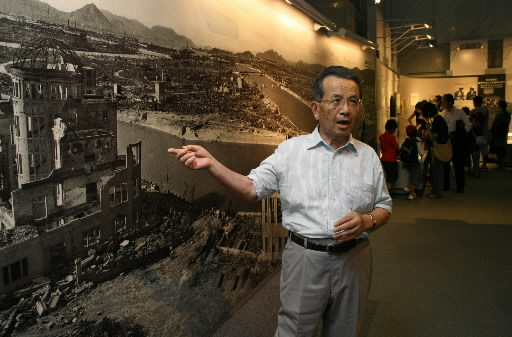Sharing the A-bomb Experience, Part 8
Aug. 6, 2009
Keeping a blog for departed friends
by Kyosuke Mizukawa, Staff Writer
He keeps a blog, writing about the current state of nuclear weapons in the world and sharing his thoughts: “My dear friends, amid the world trend toward nuclear abolition, North Korea has committed a reckless act in conducting a nuclear test.” He begins each entry with “My dear friends,” intending to convey his messages not only to the readers of his blog but also to his old schoolmates who lost their lives in the atomic bombing.
Sixty-four years ago, Mitsuo Kodama, 76, a resident of Minami Ward, Hiroshima, was a first-year student at Hiroshima First Middle School in Naka Ward. On the morning of August 6, he saw “a flash of light, like a column of flame” from his classroom window. He was about 800 meters south of the hypocenter. The next moment he found himself trapped under the collapsed school building.
He was able to emerge from the rubble, breaking through part of the roof. As he was working to free other students pinned by the wreckage, he heard one of his friends cry out for help. His friend, who sat near him in the classroom, was caught under a beam, his legs stuck fast. Mr. Kodama couldn’t pull him out.
Seeking help, he headed for the school swimming pool, where many people had gathered. But they had all been burned bright red. As he was returning to his friend, someone warned him to stay away from the building--it was now on fire. “Forgive me,” he cried to his friend, then fled.
He had no injuries, but suffered the symptoms of acute radiation sickness, including bleeding of the gums and hair loss. Among the roughly 300 first-year students who were exposed to the atomic bomb at the school or in the vicinity, only 19 managed to survive into the following year.
“I’m going to survive, even if it means gritting my teeth,” he decided. Due to his experience of the food shortage after the war, he became interested in agriculture. He learned animal husbandry at Hiroshima University and worked on a farm in Hiroshima Prefecture. He later changed careers and became involved in real estate. He worked hard and pushed his A-bomb experience to the back of his mind.
When he was 58, a job transfer brought him back to the city of Hiroshima. At the age of 60, he was diagnosed with rectal cancer and hospitalized for an operation. “I guess I’ll take it easy at home now,” he thought. Conferring with his wife, he quit his job.
Three years later, he was diagnosed with stomach cancer. Two years after that, skin cancer was found on his temples. And the following year skin cancer was detected on his right shoulder and back. He had repeated surgeries.
Something was clearly wrong. “Is this because of the atomic bombing?” he asked his doctor. The doctor nodded. He underwent a total of 14 operations between 1993 and 2006.
In 2005, he began to trace the postwar lives of his fellow students in the first year of Hiroshima First Middle School who had survived the atomic bombing. He thinks of putting his findings on his blog, as well as his own A-bomb experience and surgical history, in order to convey the horrific impact of the atomic bomb’s radiation.
More than half of the 19 students who managed to survive the blast and fire came down with cancer and 13 had died by December 2006. Among them were a former director of Hiroshima Peace Memorial Museum, a doctor devoted to the medical care of atomic bomb survivors (hibakusha), and a former teacher who often shared his A-bomb account.
Last year an official of Hiroshima Peace Memorial Museum advised Mr. Kodama to begin communicating his A-bomb experience and helped him set up the blog. “The number of hibakusha who can relate their A-bomb experiences is declining each year,” he said. With the bombing weighing on his mind, Mr. Kodama decided to “speak out now” about his experience on behalf of his friends.
At the request of a student circle at Hiroshima University, he will offer his A-bomb account in public, for the first time, on August 5. On his blog he expressed a sense of determination in advance of the talk: “I will persevere in these efforts to share my A-bomb account and hand down my A-bomb experience. No matter how heavy the burden, the thought of my friends makes me prepared to endure any hardship.”
(Originally published on July 31, 2009)








